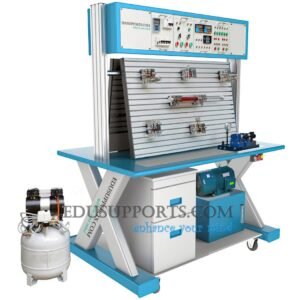The Diesel Common Rail System Trainer is designed to demonstrate the structure and operation of diesel common rail systems. It is ideal for training and practical teaching courses in intermediate and higher vocational schools, polytechnic colleges, and automobile maintenance training institutions.
- 1.Fully demonstrates the structure and operation of the diesel common rail system.
- 2.Equipped with a three-phase electric motor to drive the crankshaft and high-pressure oil pump.
- 3.Features a frequency converter to demonstrate the system’s performance at different speeds.
- 4.Includes digital displays to show real-time changes in engine sensor parameters.
- 5.Comes with a color-coded circuit diagram.
- 6.Detection terminals allow direct measurement of electrical signals from sensors, actuators, and engine control unit pins, such as resistance, voltage, current, and frequency.
- 7.Incorporates a fault setting system to simulate common circuit faults in the diesel common rail system.
- 8.Equipped with a diagnostic socket for connecting dedicated or universal car decoders to read and clear fault codes and read data streams.
- 9.Mounted on a movable wheel bench made of rigid steel with a high-temperature spray-painted surface for excellent corrosion resistance.
- Dimensions: 1250x610x1680MM
- External power supply: AC 220V ± 10% 50Hz
- Working voltage: DC 12V
- Working temperature: -40 ℃~+50 ℃
What is Diesel Common Rail System?
The Diesel Common Rail System is a modern fuel injection system used in diesel engines. It operates by pressurizing fuel in a common rail and then injecting it into the combustion chamber at high pressure, resulting in improved fuel efficiency, reduced emissions, and better engine performance. This system utilizes advanced electronic controls to precisely manage fuel injection timing and quantity, optimizing engine combustion for maximum efficiency and power output. It is widely used in modern diesel vehicles, including cars, trucks, and heavy-duty equipment, due to its benefits in terms of fuel economy, emissions reduction, and overall engine performance.



